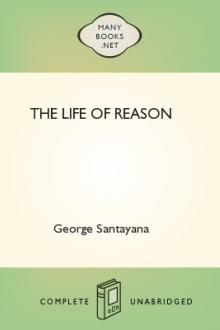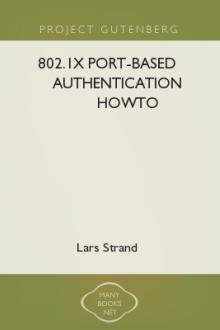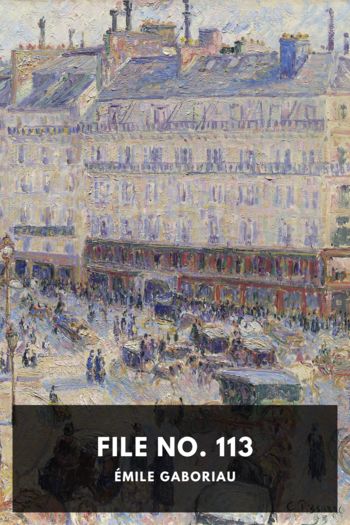The Life of Reason, George Santayana [e novels to read .txt] 📗

- Author: George Santayana
- Performer: -
Book online «The Life of Reason, George Santayana [e novels to read .txt] 📗». Author George Santayana
It is impossible, however, to imagine beforehand what these elements should be or how to combine them. The problem must exist before its solution can be found. The forms of good taste and beauty which a man can think of or esteem are limited by the scope of his previous experience. It would be impossible to foresee or desire a beauty which had not somehow grown up of itself and been recognised receptively. A satisfaction cannot be conceived ideally when neither its organ nor its occasion has as yet arisen. That ideal conception, to exist, would have to bring both into play. The fine arts are butter to man's daily bread; there is no conceiving or creating them except as they spring out of social exigencies. Their types are imposed by utility: their ornamentation betrays the tradition that happens to envelop and diversify them; their expression and dignity are borrowed from the company they keep in the world.
The Greek temple, for instance, if we imagine it in its glory, with all its colour and furniture, was a type of human art at its best, where decoration, without in the least restricting itself, took naturally an exquisitely subordinate and pervasive form: each detail had its own splendour and refinement, yet kept its place in the whole. Structure and decoration were alike traditional and imposed by ulterior practical or religious purposes; yet, by good fortune and by grace of that rationality which unified Greek life, they fell together easily into a harmony such as imagination could never have devised had it been invited to decree pleasure-domes for non-existent beings. Had the Greek gods been hideous, their images and fable could not so readily have beautified the place where they were honoured; and had the structural theme and uses of the temple been more complicated, they would not have lent themselves so well to decoration without being submerged beneath it.
In some ways the ideal Gothic church attained a similar perfection, because there too the structure remained lucid and predominant, while it was enriched by many necessary appointments—altars, stalls, screens, chantries—which, while really the raison d'être of the whole edifice, æsthetically regarded, served for its ornaments. It may be doubted, however, whether Gothic construction was well grounded enough in utility to be a sound and permanent basis for beauty; and the extreme instability of Gothic style, the feverish, inconstancy of architects straining after effects never, apparently, satisfactory when achieved, shows that something was wrong and artificial in the situation. The structure, in becoming an ornament, ceased to be anything else and could be discarded by any one whose fancy preferred a different image.
For this reason a building like the cathedral of Amiens, where a structural system is put through consistently, is far from representing mediæval art in its full and ideal essence; it is rather an incidental achievement, a sport in which an adventitious interest is, for a moment, emphasised overwhelmingly. Intelligence here comes to the fore, and a sort of mathematical virtuosity: but it was not mathematical virtuosity nor even intelligence to which, in Christian art, the leading rôle properly belonged. What structural elucidation did for church architecture was much like what scholastic elucidation did for church dogma: it insinuated a logic into the traditional edifice which was far from representing its soul or its genuine value. The dialectic introduced might be admirable in itself, in its lay and abstruse rationality; but it could not be applied to the poetic material in hand without rendering it absurd and sterile. The given problem was scientifically carried out, but the given problem was itself fantastic. To vault at such heights and to prop that vault with external buttresses was a gratuitous undertaking. The result was indeed interesting, the ingenuity and method exhibited were masterly in their way; yet the result was not proportionate in beauty to the effort required; it was after all a technical and a vain triumph.
The true magic of that very architecture lay not in its intelligible structure but in the bewildering incidental effects which that structure permitted. The part in such churches is better than the symmetrical whole; often incompleteness and accretions alone give grace or expression, to the monument. A cross vista where all is wonder, a side chapel where all is peace, strike the key-note here; not that punctilious and wooden repetition of props and arches, as a builder's model might boast to exhibit them. Perhaps the most beautiful Gothic interiors are those without aisles, if what we are considering is their proportion and majesty; elsewhere the structure, if perceived at all, is too artificial and strange to be perceived intuitively and to have the glow of a genuine beauty. There is an over-ingenious mechanism, redeemed by its colour and the thousand intervening objects, when these have not been swept away. Glazed and painted as Gothic churches were meant to be, they were no doubt exceedingly gorgeous. When we admire their structural scheme we are perhaps nursing an illusion like that which sentimental classicists once cherished when they talked about the purity of white marble statues and the ideality of their blank and sightless eyes. What we treat as a supreme quality may have been a mere means to mediæval builders, and a mechanical expedient: their simple hearts were set on making their churches, for God's glory and their own, as large, as high, and as rich as possible. After all, an uninterrupted tradition attached them to Byzantium; and it was the sudden passion for stained glass and the goldsmith's love of intricate fineness—which the Saracens also had shown—that carried them in a century from Romanesque to flamboyant. The structure was but the inevitable underpinning for the desired display. If these sanctuaries, in their spoliation and ruin, now show us their admirable bones, we should thank nature for that rational skeleton, imposed by material conditions on an art which in its life-time was goaded on only by a pious and local emulation, and wished at all costs to be sumptuous and astonishing.
It was rather in another direction that groping mediæval art reached its most congenial triumphs. That was an age, so to speak, of epidemic privacy; social contagion was irresistible, yet it served only to make each man's life no less hard, narrow, and visionary than that of every one else. Like bees in a hive, each soul worked in its separate cell by the same impulse as every other. Each was absorbed in saving itself only, but according to a universal prescription. This isolation in unanimity appears in those patient and childlike artists who copied each his leaf or flower, or imagined each his curious angels and devils, taking what was told of them so much to heart that his rendering became deeply individual. The lamp of sacrifice—or perhaps rather of ignorance—burned in every workshop; much labour was wasted in forgetfulness of the function which the work was to perform, yet a certain pathos and expression was infused into the detail, on which all invention and pride had to be lavished. Carvings and statues at impossible elevations, minute symbols hidden in corners, the choice for architectural ornament of animal and vegetable forms, copied as attentively and quaintly as possible—all this shows how abstractedly the artist surrendered himself to the given task. He dedicated his genius like the widow's mite, and left the universal composition to Providence.
Nor was this humility, on another side, wholly pious and sacrificial. The Middle Ages were, in their way, merry, sturdy, and mischievous. A fresh breath, as of convalescence, breathed through their misery. Never was spring so green and lovely as when men greeted it in a cloistered garden, with hearts quite empty and clean, only half-awakened from a long trance of despair. It mattered little at such a moment where a work was to figure or whether any one should ever enjoy it. The pleasure and the function lay here, in this private revelation, in this playful dialogue between a bit of nature and a passing mood. When a Greek workman cut a volute or a moulding, he was not asked to be a poet; he was merely a scribe, writing out what some master had composed before him. The spirit of his art, if that was called forth consciously at all, could be nothing short of intelligence. Those lines and none other, he would say to himself, are requisite and sufficient: to do less would be unskilful, to do more would be perverse. But the mediæval craftsman was irresponsible in his earnestness. The whole did not concern him, for the whole was providential and therefore, to the artist, irrelevant. He was only responsible inwardly, to his casual inspiration, to his individual model, and his allotted block of stone. With these he carried on, as it were, an ingenuous dialectic, asking them questions by a blow of the hammer, and gathering their oracular answers experimentally from the result. Art, like salvation, proceeded by a series of little miracles; it was a blind work, half stubborn patience, half unmerited grace. If the product was destined to fill a niche in the celestial edifice, that was God's business and might be left to him: what concerned the sculptor was to-day's labour and joy, with the shrewd wisdom they might bring after them.
Gothic ornament was accordingly more than ornament; it was sculpture. To the architect sculpture and painting are only means of variegating a surface; light and shade, depth and elaboration, are thereby secured and aid him in distributing his masses. For this reason geometrical or highly conventionalised ornament is all the architect requires. If his decorators furnish more, if they insist on copying natural forms or illustrating history, that is their own affair. Their humanity will doubtless give them, as representative artists, a new claim on human regard, and the building they enrich in their pictorial fashion will gain a new charm, just as it would gain by historic associations or by the smell of incense clinging to its walls. When the arts superpose their effects the total impression belongs to none of them in particular; it is imaginative merely or in the broadest sense poetical. So the monumental function of Greek sculpture, and the interpretations it gave to national myths, made every temple a storehouse of poetic memories. In the same way every great cathedral became a pious story-book. Construction, by admitting applied decoration, offers a splendid basis and background for representative art. It is in their decorative function that construction and representation meet; they are able to conspire in one ideal effect by virtue of the common appeal which they unwittingly make to the senses. If construction were not decorative it could never ally itself imaginatively to decoration; and decoration in turn would never be willingly representative if the forms which illustration requires were not decorative in themselves.
Illustration has nevertheless an intellectual function by which it diverges altogether from decoration and even, in the narrowest sense of the word, from art: for the essence of illustration lies neither in use nor in beauty. The illustrator's impulse is to reproduce and describe given objects.





Comments (0)